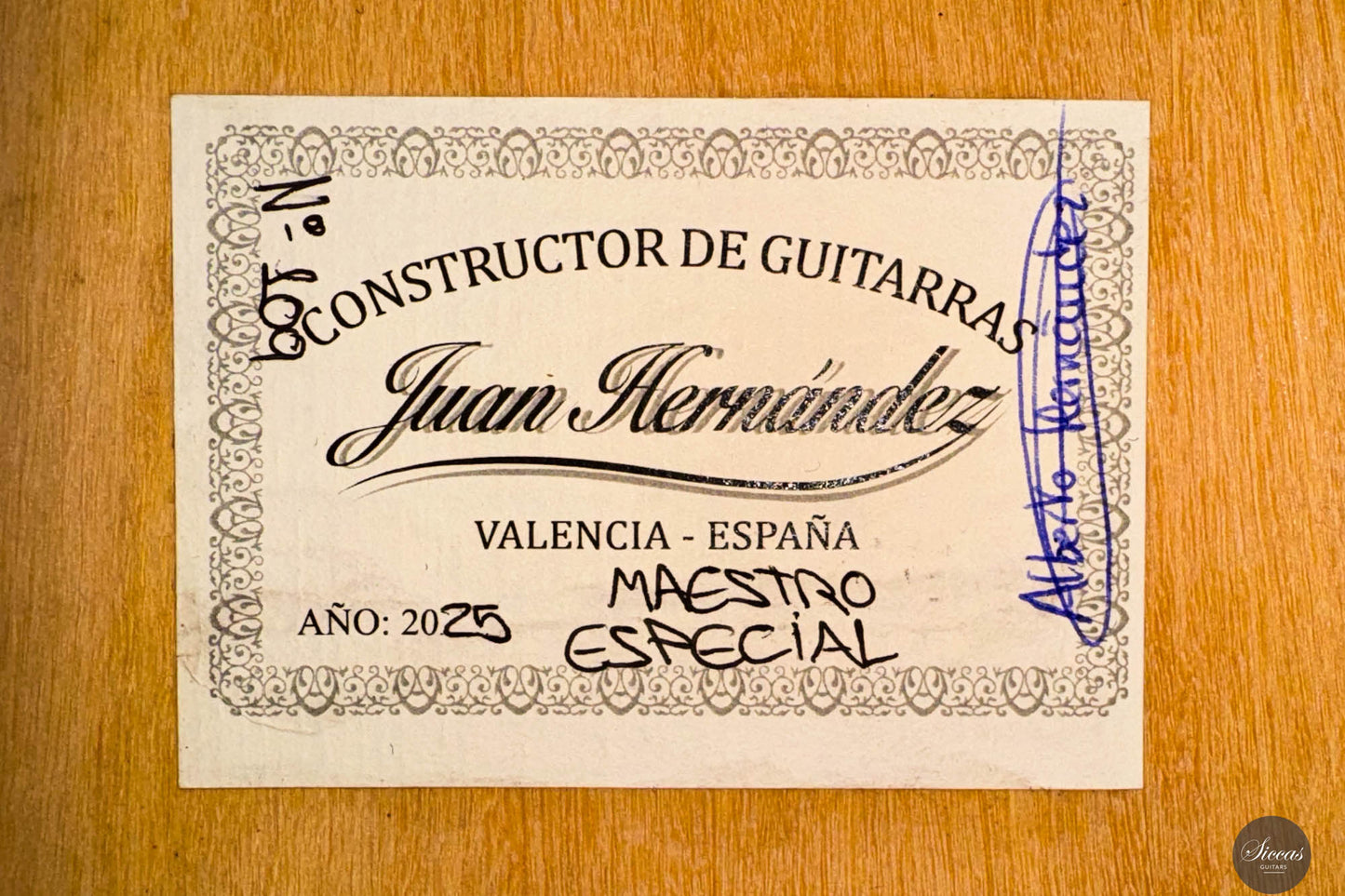Juan Hernandez - 2025 - Maestro Special N°109
Juan Hernandez - 2025 - Maestro Special N°109
Details
Details
Overview
Overview
Shipping important note
Shipping important note
Delivery times are typically reliable and most instruments arrive within the estimated timeframe.
Should any unexpected delay occur, our team will keep you informed and provide support at every step. For all shipping details and exceptions, please see our Shipping Policy.
Details about GPSR
Details about GPSR
























Video overview


More details about the guitar
About the luthier
Juan Hernández, born in 1948 in Turís, Valencia, embarked on his illustrious career in guitar-making at the tender age of 15 as an apprentice at the Esteve guitar workshop. It was there that he honed his craft and developed a deep reservoir of luthiery knowledge. Over the years, Hernández’s skills flourished, leading him to work alongside his son, Alberto Hernández, and a team of skilled artisans. Together, they have continued to uphold the high standards of craftsmanship that have earned his company an esteemed international reputation. Today, Juan Hernández is celebrated not just for his traditional techniques but also for his ability to infuse each guitar with a piece of Spanish musical heritage.About the guitar
This brand-new Maestro Especial model features a sandwich soundboard with a double-top construction, incorporating Nomex to reduce the mass of the soundboard, enhancing its responsiveness and efficiency. Despite its modern innovations, the guitar retains its rich Spanish character, making it both a powerful and expressive instrument.The soundboard reinforcement consists of five fan bracings, two harmonic bars (one positioned at the very end of the lower bout), two bridge bars, and two very thin horizontal bars made of cedar, carefully designed to balance stability and resonance. Additionally, its double sides and back construction significantly enhance projection, allowing the guitar to fill a concert hall effortlessly.
Acoustically, the guitar features velvety yet lively trebles, while the basses are dry and packed with punch, offering great articulation and clarity. Its wide dynamic range allows players to explore an incredible spectrum of tonal possibilities, making it an ideal choice for both delicate nuances and powerful passages.
The instrument is finished with nitrocellulose lacquer, ensuring durability, ease of maintenance, and a refined aesthetic. Combining power, projection, and traditional Spanish tonal beauty, this exceptional concert guitar is an ideal choice for serious musicians.
Regular care extends the life of the instrument
Even with careful use, a classical guitar may gradually change in appearance or respond to unstable storage conditions. Have a close look at your guitar regularly and be attentif to changes. If your instrument is suffering from its environement, it will let you know.
Protect Your Guitar: Handle with Care
Be mindful when touching your instrument with greasy or unwashed hands: any skin contact is a small attack on the varnish. Of course, a guitar is made to be played, but taking a few precautions helps preserve its beauty: wash your hands before playing, wear long sleeves, and avoid unnecessary direct skin contact with the body of the instrument.
Pro tip: Avoid playing with a button-up shirt, heavy jewelry, or a belt, as these can scratch the guitar. Also, make sure your guitar case is free of any objects that could damage the instrument during storage.
String care
A good habit to adopt is wiping down your strings briefly after each playing session. This small action significantly extends their lifespan and helps maintain a consistent, comfortable feel under your fingers.
Most importantly, clean strings are essential for keeping your instrument in tune. Corrosion, sweat, and dust can affect the uniformity of the strings and interfere with accurate tuning across the entire fingerboard.
Pro tip: If you're having trouble getting your guitar in tune, it might be time to change the strings. A useful test is to compare the pitch of the 12th fret harmonic with the fretted note at the 12th fret; if there's an unusually large gap between them, your strings may have lost their integrity and should be replaced.
Keep Your Shellac Finish Shining!
Got a guitar with a shellac (French polish) finish? Here's a simple trick: Take a clean microfiber cloth and gently breathe on the surface to create a light mist. Then, softly rub to remove fingerprints, sweat, and grease. That’s usually all it takes to keep it looking great, no products needed!
Pro tip: Every few years, treat your guitar to a check-up with a luthier to keep it in top shape.
Storing Your Guitar: Climate Matters
Your guitar can safely stay outside its case, as long as the surrounding environment maintains 42–55% humidity and a temperature between 18–25°C.
Keep in mind that humidity levels can still fluctuate inside the case, especially during seasonal changes.
- Too much humidity may cause overtightened strings and a dull tone.
- Too little humidity can lead to a bulging top, string buzz, or even cracks.
Avoid placing your guitar near radiators, air conditioners, or windows with direct sunlight.
Pro tip: Always close your guitar case while playing. This helps preserve a stable microclimate inside the case, so your instrument is protected the moment you put it back in.



















































